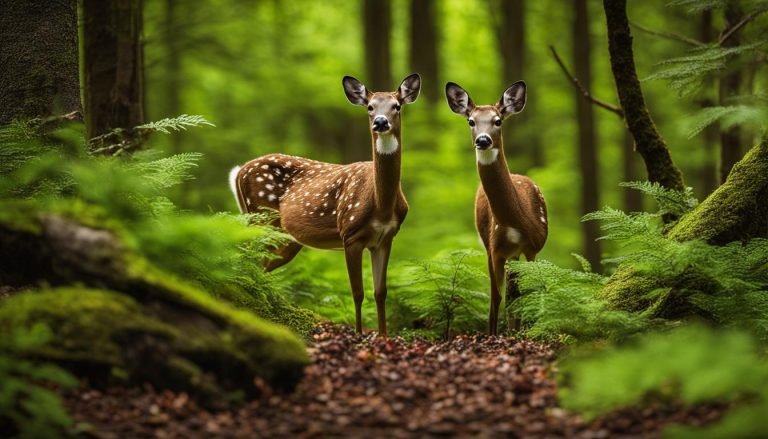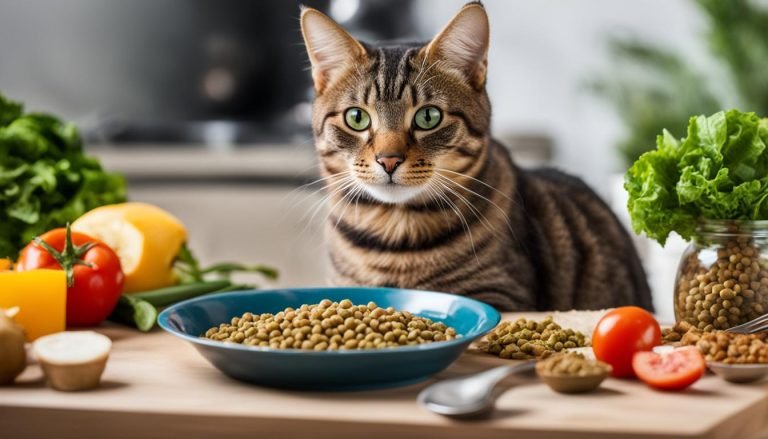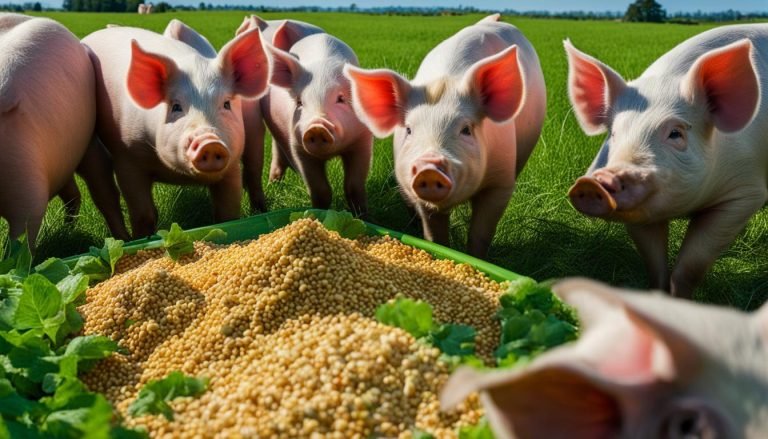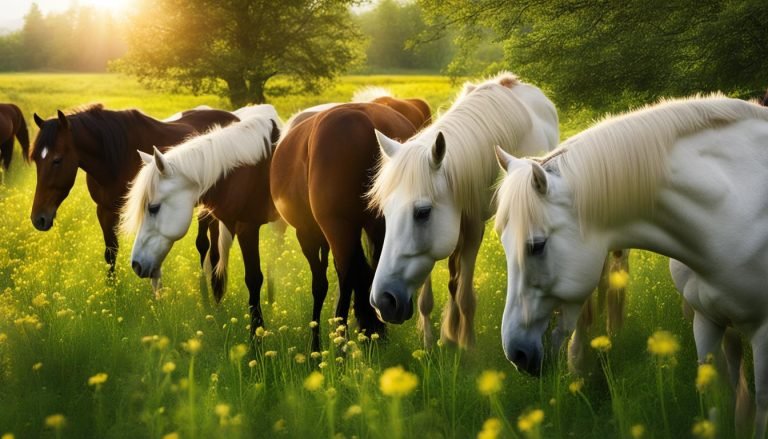What Do Monkeys Eat? Discover Their Diet Today!
Monkeys are fascinating creatures with unique dietary habits that are adapted to their natural habitats and social structures.
As a professional copywriting journalist, I have delved into the different foods that monkeys eat to provide you with insights into their dietary habits. So if you ever wondered what do monkeys eat, then keep reading this article!
Monkeys have a varied diet that includes fruits, vegetation, nuts, seeds, and even small animals. It is essential to understand their feeding behavior to better understand their diet preferences since their natural habitats and social structures influence their food choices.
In this article, we will explore the diverse diet of monkeys, including fruits, leaves, nuts, seeds, insects, and small animals. We will also discuss how human influence has impacted their diet and how caretakers ensure proper nutrition for captive monkeys.
Key Takeaways:
- Monkeys have a varied diet that includes fruits, vegetation, nuts, seeds, insects, and even small animals.
- Understanding their feeding behavior is essential to understanding their diet preferences.
- Human influence has led to monkeys adapting to consume certain human foods.
- Monkeys in captivity often require special diets and supplements to meet their nutritional needs.
- Maintaining a balanced and varied diet is crucial for the well-being of these fascinating creatures.
Monkey Quiz
How well do you know monkeys? Test your knowledge below!

Understanding Monkey Feeding Behavior
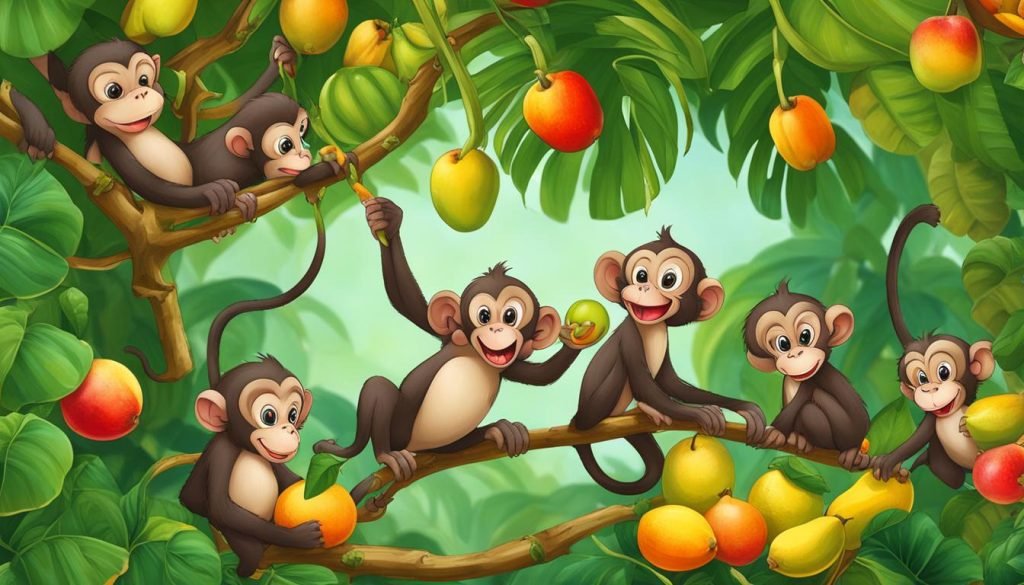
When it comes to the diet of monkeys, their feeding behavior plays a crucial role in determining their preferred foods. Monkeys are known to be opportunistic feeders, adapting their diets to the resources available in their environment.
Monkeys’ natural habitats and social structures influence their food choices. For example, arboreal monkeys, which live in trees, tend to prefer fruits and leaves, while ground-dwelling monkeys consume more insects and small animals.
Additionally, the size of a monkey’s group can also impact their feeding behavior. Large groups may need to forage for food over a wider area to meet their nutritional needs, while smaller groups may focus more on a specific food source.
Monkeys also exhibit individual food preferences, with some individuals showing a preference for certain types of food over others. This can be influenced by factors such as age, sex, and social status within the group.
Observing Monkey Feeding Behavior
Observing monkey feeding behavior can provide valuable insights into their preferred diet. Researchers have used various methods such as direct observation, fecal analysis, and stable isotope analysis to study the feeding habits of different monkey species.
For example, researchers studying the feeding behavior of black howler monkeys observed that they spend most of their time feeding on leaves and fruit, with a preference for young leaves and unripe fruit. They also found that the monkeys forage on the ground more frequently during the dry season when food resources are scarce.
Preferred Monkey Diet
Based on their feeding behavior and habitat, it is clear that a monkey’s preferred diet is diverse and varied. However, fruits, leaves, and insects are staples in most monkey diets, providing them with the necessary carbohydrates, fiber, and protein.
It is also important to note that the nutritional needs of different monkey species may vary. For example, some species may require a higher protein intake, while others may need more carbohydrates.
“By understanding the diverse diet of monkeys, we gain insight into their unique nutritional requirements.”
A Variety of Fruits on the Monkey’s Menu
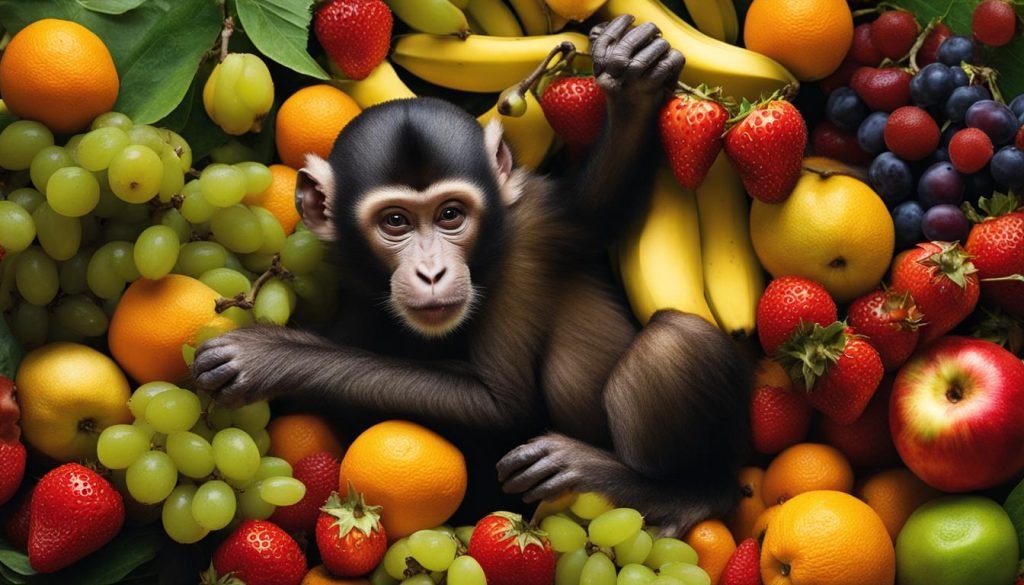
When it comes to monkey nutrition, fruits play a crucial role. A significant portion of a monkey’s diet consists of fruits, which provide essential vitamins and minerals that are vital for their overall health.
Monkeys are known to consume a wide variety of fruits, including bananas, oranges, apples, mangoes, and many others. Some monkey species prefer certain types of fruits over others, while others have a more diverse palate and consume whatever is available in their habitat.
One interesting fact about monkeys is that they have a keen sense of taste and can distinguish between ripe and unripe fruits. They will often choose the ripest fruits to consume because they are sweeter and contain higher levels of nutrients.
Here’s a table showcasing some of the fruits that monkeys commonly consume:
| Fruit Type | Nutritional Value |
|---|---|
| Bananas | A good source of potassium, vitamin C, and vitamin B6 |
| Mangoes | High in vitamin C, vitamin A, and fiber |
| Oranges | Rich in vitamin C and folate |
| Apples | Contain fiber, vitamin C, and antioxidants |
Feeding monkeys in captivity with fruits is relatively easy, as most fruits are readily available in grocery stores. However, it’s essential to ensure that the fruits are fresh and not overripe, as overripe fruits can cause digestive problems in monkeys.
In conclusion, fruits are a crucial component of a monkey’s diet, providing them with essential nutrients for their overall health and well-being. As caretakers, we must offer a diverse range of fruits in their diet to ensure they receive proper nutrition.
Nutrient-Rich Leaves and Vegetation

Monkeys are not just fruit lovers; they also consume significant amounts of leaves and vegetation. These can make up a large part of their diet depending on the species and their natural habitat.
Monkeys have evolved to digest and extract nutrients from leaves through a specialized digestive system that is longer and more complex than other primates. This adaptation enables them to break down the tough cellulose fibers found in leaves and convert them into essential nutrients.
One study found that the woolly monkey’s diet comprises mostly leaves, with fruits making up only 8% of their diet. The study also revealed that these monkeys eat more leaves during the dry season when fruit is scarce.
Here are some examples of the types of vegetation that make up part of a monkey’s diet:
| Vegetation Type | Nutritional Benefits |
|---|---|
| Bamboo leaves | High in fiber and protein |
| Tendrils and young shoots | Rich in vitamins and minerals |
| Bark and twigs | Good source of calcium and potassium |
Aside from leaves, some monkeys also consume flowers, stems, and other plant parts, depending on their availability and nutritional value.
It is important to note that not all leaves and vegetation are suitable for consumption by monkeys. Some plants can be toxic and even lethal to them. It is essential to provide appropriate vegetation or ensure that captive monkeys are not exposed to any potentially harmful plant species.
Overall, the inclusion of leaves and vegetation in a monkey’s diet provides essential nutrients that are necessary for their well-being and survival.
Nuts, Seeds, and the Monkey’s Foraging Skills

As monkeys are skilled foragers, nuts and seeds are an essential part of their diet. They have an innate ability to find and access these food sources with their agility and intelligence.
Monkeys’ excellent foraging skills enable them to locate a wide variety of nuts and seeds, making them a diverse nutrient source. Some of the most common nuts and seeds that monkeys eat include:
| Type of Nut/Seed | Nutritional Benefits |
|---|---|
| Almonds | High in protein, healthy fats, and fiber |
| Peanuts | Good source of protein, healthy fats, and vitamins |
| Cashews | High in protein, healthy fats, and antioxidants |
| Sunflower Seeds | Good source of protein, healthy fats, and minerals |
Monkeys also have a unique way of opening and extracting the nuts and seeds from their shells. They use their teeth, nails, and even rocks to crack open the hard shells and retrieve the nutritious kernels inside.
While nuts and seeds are an important part of a monkey’s diet, they should not be the sole focus. A balanced and varied diet, including fruits, leaves and vegetation, insects, and small animals, is crucial for their overall health and well-being.
A Variety of Fruits in the Monkey’s Menu
Fruits play a vital role in a monkey’s diet, providing essential vitamins and nutrients. Monkeys are opportunistic feeders, consuming fruits that are available in their habitat. Some species have a preference for certain fruits, while others consume a wide variety.
Monkeys in the wild rely on fruits such as bananas, papayas, and figs. These fruits provide carbohydrates that are vital for energy, as well as fiber that aids in digestion. Additionally, fruits such as mangoes and kiwis, are rich in antioxidants that boost the immune system.
The table below illustrates the nutritional content of the four main fruits in a monkey’s diet:
| Fruit | Carbohydrates (g) | Fiber (g) | Antioxidants (mg) |
|---|---|---|---|
| Bananas | 27 | 3.1 | 64 |
| Papayas | 14 | 2.5 | 235 |
| Figs | 19 | 2.9 | 680 |
| Mangoes | 25 | 3.7 | 126 |
It is worth noting that monkeys in captivity require varieties of fruit that differ from their wild counterparts. Caretakers must provide a nutritionally balanced diet that includes a wide range of fruits to meet the monkey’s dietary needs.
“Fruits play a vital role in a monkey’s diet, providing essential vitamins and nutrients.”
The Benefits of Fruit Consumption for Monkeys
Monkeys that consume a varied diet of fruits are healthy and have a better chance of survival in the wild. Fruits provide energy, promote good digestive health, and enhance the immune system. Additionally, monkeys that consume fruits rich in antioxidants reduce the risk of developing chronic diseases.
In conclusion, a diet rich in fruits is essential for the health and well-being of monkeys. The nutritional content of fruits provides them with the much-needed energy and essential nutrients for a healthy and balanced diet.
Monkeys and Human Food Interactions
As humans continue to expand into natural habitats, monkeys are increasingly exposed to human food sources. This interaction can have both positive and negative impacts on their diet and overall health.
While human food may provide a convenient source of nutrition, it can also lead to a variety of health problems for monkeys. Processed foods high in sugar and fat can cause obesity, diabetes, and heart disease. Additionally, feeding monkeys can encourage them to rely on humans for food, leading to a loss of their natural foraging skills.
“Feeding monkeys can encourage them to rely on humans for food, leading to a loss of their natural foraging skills.”
It is important to note that feeding monkeys is illegal in many areas and can carry hefty fines. It is crucial to allow these animals to maintain their natural diets and behaviors.
However, in cases where a monkey is injured or unable to obtain food on its own, caretakers may need to provide supplemental food. When doing so, it is important to provide a balanced and varied diet that meets the animal’s nutritional needs.
Overall, it is essential to minimize human interactions with monkeys when possible and allow them to maintain their natural diets. If necessary, supplementary food should be provided under the guidance of a professional caretaker.
Supplements and Extra Care in Captivity
Monkeys in captivity require special diets and supplements to meet their nutritional needs. As a caretaker of these intelligent creatures, I know how important it is to ensure they receive balanced nutrition that supports their physical and mental health.
Feeding monkeys in captivity can be challenging as their diet preferences vary widely depending on their species, age, and other factors. Therefore, caretakers must work closely with veterinarians and nutritionists to develop appropriate diets that meet their unique dietary needs.
Supplements such as vitamins and minerals are often added to their diets to provide extra nutritional support. For example, captive monkeys may require vitamin D supplements as they are not exposed to sunlight, which is a natural source of vitamin D.
In addition to their diet, monkeys in captivity also require extra care and attention. Providing an enriched environment that mimics their natural habitat, complete with toys and play structures, can help support their physical and mental well-being. Interaction with caretakers and other monkeys is also essential for their social development.
It is crucial to monitor the monkeys’ health continuously, including their weight, behavior, and eating habits. Any changes in these areas can indicate a health issue that needs immediate attention.
Overall, caretakers must be knowledgeable, observant, and patient when it comes to feeding and caring for monkeys in captivity. Proper nutrition and care can lead to healthy, happy, and thriving monkeys.
Conclusion

As I conclude this article, we now have a better understanding of monkey nutrition and their preferred diet. Monkeys are omnivores, with a diverse range of foods constituting their diet. A balanced and varied diet is necessary to maintain their health and well-being.
Monkeys in captivity require additional care and attention to ensure they receive the proper nutrition. With the use of supplements and specialized diets, caretakers can provide the necessary nutrients for these animals.
It is vital to appreciate the significance of monkey nutrition in understanding their behavior and overall health. By maintaining a healthy diet that includes fruits, leaves, vegetation, nuts, seeds, and proteins, we can help ensure their long-term survival.
In conclusion, let us strive to protect these fascinating creatures by supporting conservation efforts and promoting responsible feeding practices. Together, we can make a difference in the lives of these incredible animals.
More About Monkeys:
- How Do Monkeys Mate? – Explained
- How Long Do Monkeys Live? Lifespan Explained
- 15 Facts About Monkeys That Will Fascinate You
- Monkey Quiz: How Well Do You Know Monkeys?
Frequently Asked Questions
What do monkeys eat?
Monkeys have a varied diet that includes fruits, leaves, vegetation, nuts, seeds, insects, and small animals.
How does a monkey’s natural habitat influence its diet?
A monkey’s natural habitat and social structure impact its food choices and feeding behavior.
What role do fruits play in a monkey’s diet?
Fruits are an essential part of a monkey’s diet, providing them with important nutrients.
What types of leaves and vegetation do monkeys eat?
Monkeys consume a variety of leaves and vegetation to meet their nutritional needs.
How do monkeys find nuts and seeds?
Monkeys use their agility and intelligence to forage and access nuts and seeds.
Do monkeys eat insects and small animals?
Some monkey species incorporate insects and small animals into their diet as a source of protein.
How do monkeys interact with human food?
Monkeys have adapted to consume certain human foods due to human influence.
What special care is needed for monkeys in captivity?
Monkeys in captivity require special diets and supplements to meet their nutritional needs.
Why is a balanced and varied diet important for monkeys?
A balanced and varied diet is crucial for the overall well-being of monkeys and their unique nutritional requirements.


